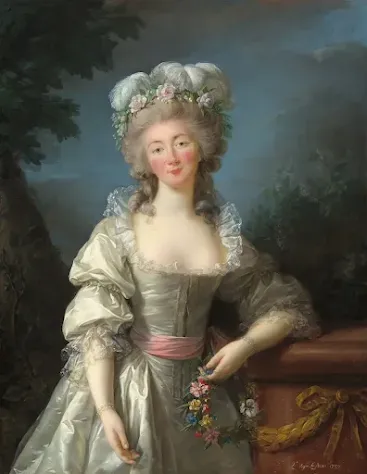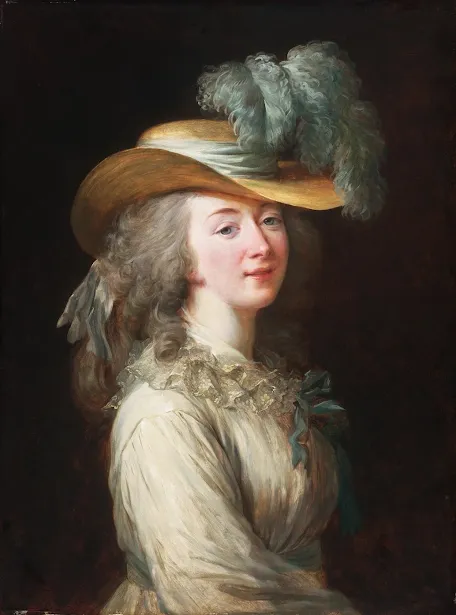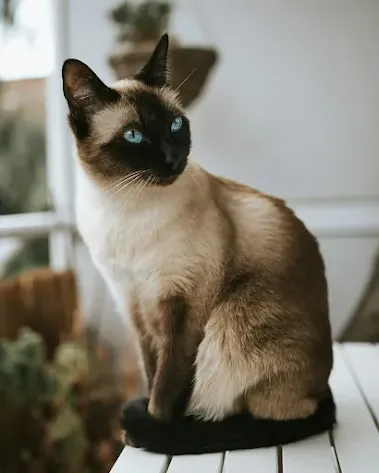Madame du Barry's Domestic Pets: The Unknown History of Versailles
Madame du Barry
In 18th-century France, it was all about sparkling parties and scrumptious feasts, but did you know that Madame du Barry also had a soft spot for household pets?Although faced with tiring court intrigues, Madame de Barry could find solace and strength in the company of her cherished pets. Each of her pets, from the elegant cats lounging in her private room to the colorful birds flying in her sunny chambers, contributes to the image of a captivating, refined, and charming woman whose character captivated even the king.
Madame du Barry was born in Vaucouleurs, France, on August 19, 1743. She was the daughter of Anne Bécu, a seamstress, and potentially a friar named Jean-Baptiste Gormand de Vaubernier. Jeanne's upbringing was marked by modesty and lack of fame, a stark contrast to the luxurious environment of the French court where she would eventually reside.
Due to her mother's contacts, Jeanne ended up in Paris and secured employment as a seamstress and hat maker. She gained attention of several affluent men in Parisian society, specifically the Comte du Barry, who became her romantic partner and later facilitated her introduction to King Louis XV's court.
After becoming the official mistress of Louis XV., Madame du Barry developed a magnificent salon, unlike any previous lady in the French royal court. In addition to the famous painters, poets, and writers invited and with whom she formed friendships, she made it home for her domestic animals.
Du Barry's pet collection revolved primarily around monkeys. The choice of these extremely strange creatures appears to be an attempt to set herself apart from the King's previous intimate concubines.
A Glimpse into the World of Madame du Barry
Madame du Barry, also known as Jeanne Bécu, became the mistress of King Louis XV in 1768 upon capturing his attention at the court ball. Recognized for her attractive appearance and lively character, she rapidly gained popularity and became a preferred companion of the elderly king. In contrast to Madame de Pompadour, Madame du Barry encountered strong resistance from the nobility because of her modest background.Due to her mother's contacts, Jeanne ended up in Paris and secured employment as a seamstress and hat maker. She gained attention of several affluent men in Parisian society, specifically the Comte du Barry, who became her romantic partner and later facilitated her introduction to King Louis XV's court.
Du Barry's pet collection revolved primarily around monkeys. The choice of these extremely strange creatures appears to be an attempt to set herself apart from the King's previous intimate concubines.
Madame du Barry sought to present herself as a distinctive woman with individual viewpoints and preferences, distinguishing herself through her selection of animal companions.
Du Barry Capuchin monkeys dressed in tiny royal outfits strolled through the opulent corridors of Versailles, delighting visitors with their stunts and bringing a comical element to the court splendor. The capuchin monkey's charming presence also added an extra layer of enjoyment to Madame du Barry's gatherings with her beloved courtiers and acquaintances.
Madame du Barry's parrot collection was as vast and colorful as the feathers on her beautiful hats. Several renowned breeds were among her cherished parrots, each providing a unique color and personality to the settings of her parties.
Pomeranians are welcome in any situation or company. These little doggies are loved for their personality and graceful look. Because Pomeranians have unique double coats and look like foxes, their small size doesn't stop them from exuding confidence and charm, making them popular pets.
Capuchin Monkeys
 |
| Capuchin monkeys are both curious and intelligent, and capable of forming deep emotional connections with humans |
Capuchin monkeys are distinguished by their distinctive fur coat, usually in shades of brown or black with lighter hues on their faces and chests. Their bodies are sleek and agile, and their expressive faces are accented with round, wide-set eyes that convey both curiosity and intelligence. Capuchins' remarkable dexterity can be attributed to their prehensile tails and nimble fingers, which enable them to grasp objects and navigate their environment with ease. Capuchin monkeys are known for their playful and inquisitive nature in terms of behavior.
Their intelligence is often displayed through problem-solving and exploration.
Curious by instinct, they eagerly investigate their surroundings, using their keen senses to forage for food and engage in social interactions with other members of their group. Capuchins are known for their social nature, forming close-knit family groups that depend on cooperation and communication for survival. Within these groups, they exhibit complex social hierarchies, with individuals vying for dominance through displays of aggression or submission.
Parrots
Along with her monkey buddies, Du Barry kept a beautiful collection of parrots, who with their brilliant plumage and abilities to mimic human speech, added a splash of color to every courtly festivity. Their presence offered an exotic twist, sending guests to faraway locations with their tropical calls.
Madame du Barry's parrot collection was as vast and colorful as the feathers on her beautiful hats. Several renowned breeds were among her cherished parrots, each providing a unique color and personality to the settings of her parties.
 |
| Madame du Barry liked to spend time in her private chambers in the company of colorful and talkative parrots |
First and foremost, the beautiful macaws with their brilliant blue, green, and yellow plumage and impressive size and striking appearance. The symbol of wealth and exoticism. Madame du Barry's macaws included species such as the Scarlet Macaw (Ara macao) and the Blue-and-Yellow Macaw (Ara ararauna). Besides macaws, Madame du Barry possessed smaller parrot species, like the charming lovebird or the elegant cockatiel. The vibrant plumage and affectionate nature of lovebirds made them popular companions among French nobility due to their endearing displays of courtship and companionship. With their distinctive crest and melodious chirps, cockatiels added elegance to every occasion.
Dogs and Cats
Not content with species that prefer trees only, Du Barry also enjoyed the company of dogs generally of rarer breeds than the then-popular Papillons and Phelanes (who were Madame de Pompadour's favorite pets).
Her devoted Pomeranian, Coco, was among them.
 |
| Pomeranian dogs are cute toy breeds that make brilliant companions. According to some sources, Madame du Barry owned a Pomeranian named Coco |
Among cats, Du Barry preferred cats that were graceful and elegant, such as Persians and Siamese.
Among her treasured companions were her Persian cats, named Duchess and Marquis.
Siamese cats possess a slender and strong physique, along with striking blue almond-shaped eyes that captivate all who gaze upon them. They have a short, fine fur in different colors, with darker shades present on the ears, face, paws, and tail and lighter shades on the rest of the body.
Siamese cats are famous for their vocal skills, enjoying chatting with their human friends using a range of vocalizations to convey their thoughts. Siamese are very intelligent and inquisitive, enjoying mental challenges and interaction. They often seek out attention and playfulness from their human companions. They form strong bonds with their owners and are recognized for their loving and faithful nature.
In the opulent courts of 18th-century France, where extravagance knew no bounds, Jeanne du Barry, carved out her own space that make her stand out. Du Barry's extravagant lifestyle and penchant for exotic creatures sparked controversy. Her opponents frequently cited her extravagant expenditures as evidence of her frivolity, and through critic of her persona they subtly criticized the King. Especially at a time when many French people were struggling financially.
Nevertheless, when faced with criticism, she stayed true to herself. In her own realm, where animals roamed freely, she discovered solace among the busyness of courtly existence, encircled by charming and delightful animals that bring simplicity to life.
In a world of men, Madame du Barry was able to maneuver with skill, while her love for animals served as a reminder of the simple pleasures that transcend wealth and status. Du Barry's love for animals extends beyond mere companionship; it was a reflection of her deep appreciation for the beauty and diversity of the natural world.
When we think about Jeanne du Barry's legacy, we should not only recall her as an enchanting figure in French history but also as a strong woman who influenced history. She defied societal norms and gained power in a male-dominated era, while still able to appreciate the beauty of the natural world and the presence of animals, big and small.
Before Madame du Barry, another notable figure in the French court who admired Persian cats was Madame de Maintenon. Madame de Maintenon was the second wife of King Louis XIV of France. She held considerable influence over the king and was deeply involved in court affairs. Madame de Maintenon had a fondness for Persian cats and often kept them as companions in her private chambers at the Palace of Versailles.
Persian cats are have long flowing coat that needs regular maintenance to maintain luxurious look. Their regal appeal is enhanced by their broad, expressive eyes and distinct flat face. Persian cats are well-known for their calm and easygoing attitude, making them perfect for low-key homes. They love lounging in comfort, often resting on plush pillows or basking in sunny spots around the house. Siamese cats are famous for their vocal skills, enjoying chatting with their human friends using a range of vocalizations to convey their thoughts. Siamese are very intelligent and inquisitive, enjoying mental challenges and interaction. They often seek out attention and playfulness from their human companions. They form strong bonds with their owners and are recognized for their loving and faithful nature.
Legacy
In the opulent courts of 18th-century France, where extravagance knew no bounds, Jeanne du Barry, carved out her own space that make her stand out. Du Barry's extravagant lifestyle and penchant for exotic creatures sparked controversy. Her opponents frequently cited her extravagant expenditures as evidence of her frivolity, and through critic of her persona they subtly criticized the King. Especially at a time when many French people were struggling financially.
Nevertheless, when faced with criticism, she stayed true to herself. In her own realm, where animals roamed freely, she discovered solace among the busyness of courtly existence, encircled by charming and delightful animals that bring simplicity to life.
 |
| Madame du Barry aged gracefully in the company of her pets |
In a world of men, Madame du Barry was able to maneuver with skill, while her love for animals served as a reminder of the simple pleasures that transcend wealth and status. Du Barry's love for animals extends beyond mere companionship; it was a reflection of her deep appreciation for the beauty and diversity of the natural world.





Comments
Post a Comment